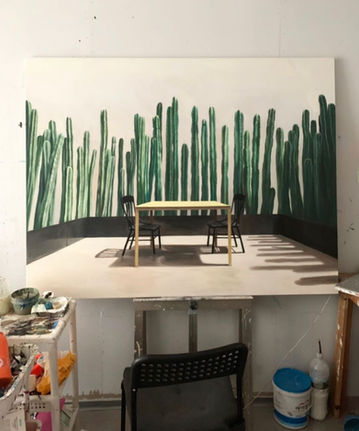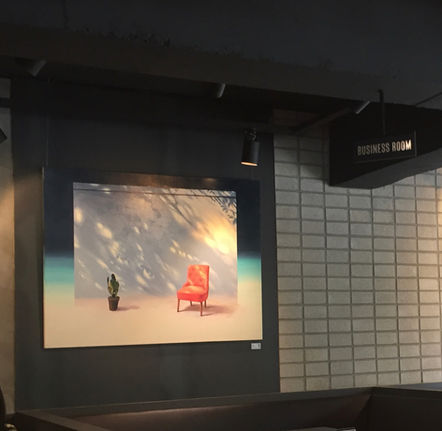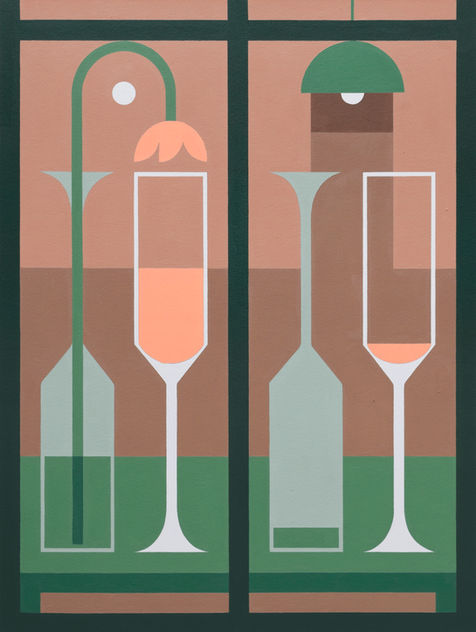
Q & A
The curators asked each artist a few questions about their current living situations considering how the pandemic changed everything in such a short time. Meanwhile, some of the artists chose to share pictures about their creative lives, and/or anything in their mind that can answer our question.
Leave a message here or DM Tutu Gallery @gallerytutu on Instagram if you have any questions for the artists or curators. We will update the answers and add them here.
Sohyun An
(b.1984) is a painter and illustrator who currently lives and works in Bucheun, South Korea.
Instagram| Website
Artist Statement
When you don't want to do anything
Doing nothing
Focus only on my self
Exhale slowly
Let everything rest
Not to lose consciousness, sleep, or dream
Resting all of me with awake mind
After taking a breath for relaxation only
It feels more transparent and clear
Feels like the things that made me cluttered and complicated flew away
I became lighter than anything else
I stand still, nothing else
Q & A
Tutu: How are you responding to the pandemic and how doe it affect your art practice?
Sohyun: I think it's painful and difficult.
I just want my painting to be a little warm comfort to those who are lonely while social interaction with sick people is blocked.
I keep working hard like that.
Su A Chae
is a South Korean visual artist, currently based in the Midwestern United States. She received an MFA in Painting from Indiana University Bloomington and an MA and a BA in Business from Ewha Womans University in Seoul, South Korea. Her work has been exhibited at venues such as the Ortega y Gasset Projects in Brooklyn, the Painting Center in New York, the Icebox Project Space in Philadelphia, the Harrison Center in Indianapolis, Indiana University in Bloomington, Young Space and others. Her work has been appeared in print including Studio Visit, Create! Magazine, Maake, Friend of The Artist, Herald-Times, and others. She was an artist-in-residence at Vermont Studio Center, attended a painting workshop at Penland School of Craft as a recipient of the Higher Education Partner Program Scholarship, and completed the Tyler School of Art Summer Painting & Sculpture Intensive. Su A Chae has been recently selected as a finalist for the Hopper Prize.
Instagram | Website
Artist Statement
My painting investigates the ambivalence associated with identity and asymmetrical balance that creates paradoxical spatial propositions.
I employ (semi-)abstraction as a means of extracting
my cultural and autobiographical—often intertwined
with social and political—identity. The grids, squares, and patterns serve as a vehicle for describing separation, interference, confrontation, and tension, as well as an underlying structure. The lattice or checkerboard-like structures that resemble a fence or a gate speak of a physical, psychological or cultural barrier that I have experienced since I moved to the United States. The rectangles are simplified but non-universal visual information that contains my personal and cultural perceptional experience.
Grounded on my belief that art can be a remedy to counteract the effects of social imbalance, I use asymmetrical balance of shapes, patterns, colors, and textures to deliberately create paradoxical spatial propositions. An organic, microbiological, or cosmological quality frequently appears in my paintings as a marker of personal and cultural memory and as well as a counterbalance to rigidity embedded within my paintings. I intend the gentle and tempting colors accompanying with wild and agitating elements to invite the viewers to the enigmatic mindscape where they see their own multi-layered images as reality.
As a Xennial who has had an analog childhood and a digital adulthood, I tend to make a painting that looks digital but still remains the materiality. While maintaining the physicality, my paintings where gradational colors are paired with textural surfaces chase the digital aura.
The tension and ambiguity between the micro and the macro, the interior and the exterior, and the illusionary and the material within a paradoxical space interrogates about what it is what we see. I hope to open up a larger conversation of diversity and coexistence in social context. My paintings allow the rigid structures to be the places of human possibility rather than suppression within these structures live anger, anxiety, playfulness, and hope, and the possibility.
approach to my art practice with the interest in the digital media.) I am ready to go back to my studio barn to infuse the vitality and the materiality into my digital studies that I have made by producing physical paintings.
Tutu: What inspires you the most right now?
Su: Deglobalization and connectivity, individuality and solidarity, and relationship between humans and nature are what I am thinking of right now. The pandemic allows me to have more time to read a variety of books. In particular, I am reading again some classics, dystopian novels, and history books that I enjoyed reading many years ago, such as the works by Dante, Albert Camus, Jonathan Swift, Aldous Huxley, José Saramago, Jered Diamond and others. As we seek to grasp our past’s lessons for our future, I am reading those books to gain insights into this uncertain circumstances and, hopefully, the future. Besides reading alone at home, I am attending a book club via Zoom to meet my friends and to discuss books. We are currently reading a survival story of a young boy in the wilderness, that can inspire us to have hope and resilience in a challenging situation. Reading books not only helps me experience and analyze the world through others’ lives but also foster and practice imagination. I am seeking to visualize what I’ve read, thought, and questioned in the form of painting.

Q & A
Tutu: How are you responding to the pandemic and how does it affect your art practice?
Su: After experiencing a state of confusion, anxiety, and lack of motivation, I am adapting to the new life for artistic creation. I have been reflecting what I have done, researching painting ideas, making digital painting, and exploring other digital media such as 3D modeling programs at home since the state implemented stay-at-home order. I was always eager to find the ways to incorporate the digital quality-the immateriality-into my art practice before the pandemic. Oddly, the pandemic, that forces me to do many things online and in the digital space, assures me of the importance of liveliness that painting presents in the form of a material object. (It may be my psychological reactance to the forcible and irresistible
circumstances, but I know I will keep developing a new
Karen Y. Chan
(b. New York, NY) is an interdisciplinary artist based in New York, NY. In the last year and a half, she devoted much of her time to writing poetry for her forthcoming chapbook, Your Body Is an Idea. Chan writes about the complexities of emotions in states of love, limbo, and uncertainty, while exploring ways to integrate poetry and experimental texts with her videos and installations. She is also co-editor of Caddisfly Project, an artists’ magazine launching in 2020.
Chan has exhibited work at the Queens Museum (Flushing, NY), Pratt Institute (Brooklyn, NY), MITU580 (Brooklyn, NY), Ed. Varie (New York, NY), AC Institute (New York, NY), BronxArtSpace (Bronx, NY), Roman Susan (Chicago, IL), Fernway Gallery (Chicago, IL), Vox Populi (Philadelphia, PA), Klaus Center for the Arts (San Pedro, CA), Alexander Calder Fine Arts Center (Allendale, MI), M23
(Miami, FL), Rochester Contemporary Art Center (Rochester, NY), amongst others.
Her collaborative multimedia project with musician and composer JunYi Chow was awarded the Queens Council on the Arts New Work Grant, and was presented at Flushing Town Hall (Flushing, NY) and Jamaica Center for the Arts and Learning (Jamaica, NY).
Chan was Artist-in-Residence at The Studios at MASS MoCA (North Adams, MA), Banff Centre for Arts and Creativity (Alberta, Canada), and Transart Institute (Berlin, Germany). She holds an MA in Media Studies from The New School and a BA in Journalism from New York University (New York, NY).
Instagram| Website
Artist Statement
As an interdisciplinary artist, I explore ways of unraveling complex and everyday emotions—such as fear, longing, and grief—laying bare vulnerabilities and questions surrounding intimacy. I mix media and methods that include projecting film and video, building assemblages with found objects, constructing distinctive environments with light, and writing poetry. There is often a dialogue that happens between the mediums, where one might inform the other, sometimes coming together as a continuous gesture. Working this way, I create opportunities for meditation on hard-to-grasp feelings and moments of uncertainty.
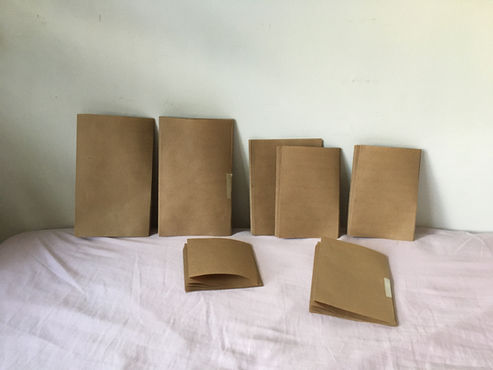
Q & A
Tutu: How are you responding to the pandemic and how does it affect your art practice?
Karen: This moment has forced me to face fear and uncertainty. I find myself in limbo and in search for grounding things. Like texts from family living far away, long conversations on the phone, and sharing music, books, and movies with friends. Sharing what worries us. Even anxiety-filled trips to the grocery store helps to mark time. I find myself longing all day, for my studio, for flowers, for sun, for connection. But, I am grateful to be safe. I am grateful that I can express safely the range of emotions I feel through writing poetry and collaborations with other artists. I am learning how to be a person again. I am questioning how to be an artist again and how my work needs to change in a changing world.
Xingjian Ding
grew up in Shanghai and Southern California. Using picture making as an ongoing biographical expression, each picture capsules a certain memory, sensation, scenario, or thoughts that kept static throughout. His works typically illustrate a quiet and lone atmosphere through an observer’s lens with toned-down colors, crisp edges, and white space being commonly used motifs. He is currently based in New York..
Instagram| Website
Artist Statement
My plant was a good-looking plant. At its prime, its tentacles spiraled out, bursting with life especially under a warm, artificial light. My plant went through different stages and for that period of time, I just left it out on the balcony and let the weather do its thing. It might have been neglected but looking back, it was indeed its prime. I never learned about my plant. Years later, I made efforts and brought it back to life from the verge of death but just to see it fade again, in style and for good this time. I threw away every bit of it, even the pot.
The camera lens turns the corner and pans upwards towards the end of the staircase, steadily... steadily... moving up the staircase that led to the master bedroom. Step by step, the P.O.V. creeps up the staircase un-rhythmically, a strange dolly shot. There is an imaginary high-pitched buzzing sound in the atmosphere that is making me nauseous.
I'm the spectator and I am also the P.O.V. It’s as if a horror film without any horror scenes.

Q & A
Tutu: How are you responding to the pandemic and how does it affect your art practice?
Xingjian: Things got worse before they got better, and I am a particle. Wonder-full and pitiful. The thought of it ALL may sometimes feel melancholic. Love seems unspeakable but lingers. Girl is a mirror, may be a mirage, a reveal. Torrents hit, time creeps. What can I hold on? Please carry on consciously for my own sake of mind. Beginning of an end.
Baoying Huang
was born and raised in Shenzhen, China and moved to New Jersey with her family. She was introduced to painting and drawing at a very young age and received a BFA degree at The School of Visual Arts, New York.
Instagram| Website
Artist Statement
I like to paint ordinary things that are close to me. They are from specific settings such as bedrooms, hospitals, and trains. I was born in Shenzhen, China; urban life is deeply imprinted in me. Walking through the concrete jungle every day as a child, I witnessed a growing city and the lives of many people in it. I have always observed the city like a surveillance camera. When the rhythm of this megacity makes it hard to breathe, art is my haven. I question what pushes us to move fast and what can calm us down when we miss an uptown express train.
Some people in megacities can be upset easily because they lose their ability to pay attention to the world. I think that pure happiness comes from little moments such as a cup of hot tea shared with a friend or staying at home with pets on a casual afternoon. These are the jewels and candies in my pictures, as I invent a tasty medicine to remind city people of their precious times. The positive interpretation of contemporary lifestyle is crucial to my practice, and I sometimes reference documentaries about the different aspects of city life.
Many of my paintings were inspired by medical documentaries and touched on the power of humanity. I convey this through everyday scenes such as athletic fields and train stations. Those stories gave me
tremendous strength to stay optimistic, and I believe that the courage in our spirit does not have to be awakened by grievous subject-matter; it exists when we believe in humanity and love the world.
I am interested in the narrative aspect of an image, and I incorporate curtains as main characters in many of my pictures. This stems from a childhood accident. I used to swing from a huge piece of curtain in my grandparents’ home. As I grew up and got heavier, the rod fell and hit my forehead. That was my first memory of being in a hospital and the most significant memory I have of my childhood. I care about the subtle psychological impact that my work can have on the world, and I want my audiences to react.
I am currently exploring an abstract approach to my work. The gouache paintings from this Fall were inspired by time-lapse videos I recorded on a train. Triggered by the shape of the window, I made the paintings in the unfolded format of a traditional Chinese lantern. My images are based on photographs I take. With improvisational editing, I paint with emotion and apply colors rationally to state specific themes.
With the development of technology, a painting can reach many more viewers than before; therefore, I think it is important to stay genuine and sincere out of responsibility to my audiences and respect for art. Only authentic artwork can attract people with similar energy. I want my work in the contemporary art world to be a mirror of city life and people’s psychological states.
Q & A
Tutu: How are you responding to the pandemic and how does it affect your art practice?
Baoying: I left New York two months ago since there has been the center of the pandemic. Now I’m living in Boston with my partner. Activities like seeing shows and going to the museum have to be temporarily removed from my daily life, like every other artist has to, too. During the pandemic, I can only work on some small pieces on paper, and I tend to draw from life. I feel like we have never been so close to our mundane life ever. The things that inspire me the most right now are the necessary needs that can bring us calm. The time I spent around the kitchen now has been more than anytime in history, and I enjoy drawing still life while waiting for the beef to be simmered.
KunKun
is an artist living and working in Shanghai and New York.
Q & A
Tutu: How are you responding to the pandemic and how does it affect your art practice?
Kunkun: Staying home. Inspiration: 0.

Shohei Miyachi
is a photographer from Shizuoka, Japan. He holds a BFA in photography from the School of Visual Arts and an MFA in photography from Pratt Institute.
Instagram| Website
Artist Statement
Rehab is a therapeutic performance I conducted with a woman suffering from fibromyalgia and sexual trauma. Her life, isolated from the society, drastically changed after she decided to hookup with strangers she met online.
As a photographer, performing partner and one of her online acquaintances, I engaged with the moments in which she re-experienced fragments of disturbance, rejection and agony. During each performance, she became more aware of the pain performance, she became more aware of the pain burning throughout
her body and harshly oppressing her psyche. I witnessed great conflict as she began to shamelessly confront the dominant part of herself. Confused and exhilarated, she developed an aggressive need for new and diverse encounters. However, the ease and superficiality of these connections left her with a sense of disappointment.
The manipulation of her mind and body through this erotic experimentation, at first, seemed to free her from her physical limitations and traumatic memories. Yet in the end, it only revealed her vulnerability and a longing for a genuine romantic relationship. Rehab continues to abandon her in her endless search for a true retreat.

Q & A
Tutu: How are you responding to the pandemic and how does it affect your art practice?
Shohei: I’ve been using this quarantine time to revisit my archive, re-edit the images, print them out or see them as projection in my home studio to experiment. I’m usually a go-out-and-shoot type of photographer, so I actually appreciate having this whole chunk of studio time to rethink what I have made and my image-making process in general.
Tutu: What inspires you the most right now?
Shohei: Snapshot images from my parents’ photo album. I’ve been working with my parents’ family archive for a while now, and I’m looking forward to sharing the project soon.
Sohyun An - Su A Chae - Karen Y. Chan - Xingjian Ding - Baoying Huang - KunKun - Sicheng Wang - Adrian Kay Wong - Yiwen Xie - Guimi You - Diana Zeng
Masamitsu Shigeta
(b. 1992) moved from Tokyo, his homeland, to New York in 2013. Here, he pursued his passion for painting and graduated with a BFA from the School of Visual Arts in 2018. Currently, Masamitsu is a first-year MFA candidate at New York University, where he enjoys experimenting with mixed media abstraction and metaphysical conceptualization.
Artist Statement
My Painting is About Joy. I keep excitement from my experience and explore in my painting. When I walk around I find many things. Flowers, trees, shadows, etc. I paint some of these things as motives. however, I'm not trying to capture these motives. I’m painting a moment of my mind instead. I’m seeking the encounter point between observation and imagination. Therefore I often introduce what I don’t see in motives in painting. For Instance patterns.
Q & A
Tutu: How are you responding to the pandemic and how does it affect your art practice?
Masamitsu: When the rock down have began I stop painting for about two weeks. I was asking my self why do I paint in this hard time. And I answer myself because I want to see my new practice a lot. Not only limited materials, Space, but mentally. I think this situation ask me what do I really want to Paint. What is argent to paint.
Tutu: What inspires you the most right now?
Masamitsu: When I go out for a walk I realized even this very trying time I could find very nice things like flowers, trees. I see Light a some king of optimistic hope in it. Also I look back my Photo I have been taking even before Pandemic. Inspiring thing is Something make me think argent to paint right now.
Sohyun An - Su A Chae - Karen Y. Chan - Xingjian Ding - Baoying Huang - KunKun - Shohei Miyachi - Adrian Kay Wong - Yiwen Xie - Guimi You - Diana Zeng
Sicheng Wang
(Born Wuhan 1992) is an artist living and working in New York and Wuhan, whose works range from painting, installation, performance to video and new media like 3D animation and VR interactive.
Artist Statement
In Sicheng’s practice, he expresses his experience and understanding of the mysterious life flow through a poetic expression of different media. Artist uses his works to explore the personal, cultural, and historical connections between his homeland and other places. Meanwhile, he also wants to show how the impact of different ideologies and rapidly developing science and technology in his society has shaped him.
Q & A
Tutu: How are you responding to the pandemic and how does it affect your art practice?
Sicheng: Everyone has been affected more or less of novel coronavirus epidemic this spring. As a Wuhan-born artist, I painted a special diary in my way. which came from my own experience during the quarantine in Shanghai in Jan.
Tutu: What inspires you the most right now?
Sicheng: How society shapes me.
Adrian Kay Wong
Adrian Kay Wong (b. 1991) is a visual artist working primarily in painting, with involvement in installations, murals, and other disciplines.
Wong's work depicts figures and settings in a minimalistic manner, developing visual systems in his image-making method. This involves a compositionally focused approach, abstraction of forms, repetition of shapes, and controlled color decisions. His work is also characterized by a subversion of depth through a flattening and segmentation of surface.
His subject-matter pertains to the ordinary environments of the everyday, examining more subtle dynamics that are often considered sedentary, overlooked, or sentimental.
Wong was raised in the east San Francisco Bay area and now lives and works in Los Angeles, CA after receiving his BFA from the School of the Art Institute of Chicago in 2013.
Instagram| Website
Artist Statement
Adrian Kay Wong’s work reserves a sentimentality for the quiet and ordinary settings of the everyday. His paintings isolate and encapsulate these moments, looking to examine the visual details and structures that compose them.
Wong investigates a cohesiveness in his image-making through the repeating of basic gestures in the construction of his shapes. Compounded by a visual alliteration of duplicated forms and reoccurring motifs, Wong establishes an organizational method that explores relationships in fundamentals of color, value, composition, and form. Wong levels the attention between primary visual alliteration of duplicated forms and reoccurring motifs, Wong establishes an organizational method that explores relationships in fundamentals of color, value, composition, and form.
Wong levels the attention between primary subject and contextual detail by a deliberate flatness of surface, intensifying subtle dynamics within the painting. This extends to his subject matter in the same way through Wong’s regard for the fleeting and overlooked. The paintings look to discover and glorify these scenes often missed — the sedentary, the mundane, the melancholic.
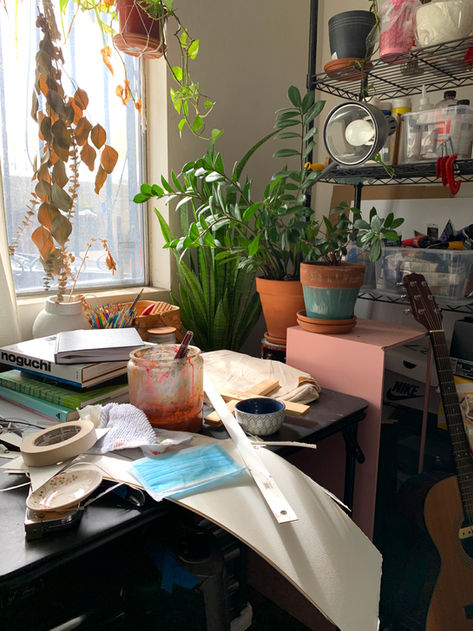
Q & A
Tutu: How are you responding to the pandemic and how does it affect your art practice?
Adrian: There is innately a solitary aspect to the creative process, so in the day-to-day, I have the privilege of being mostly unaffected. I spend most of my time in the studio and making work. Nonetheless, I've found a strong sense of fulfillment by exploring ways to focus my work into opportunities that could somehow help others that are feeling a deeper impact by these challenging times. Fittingly, my subject-matter in the overlooked, melancholic, and ordinary spaces of the everyday draws many parallels to situation at hand. Ultimately, this pandemic has really reframed the perspectives in which we view and cherish our daily experience.
Tutu: What inspires you the most right now?
Adrian: I'm inspired most by seeing my friends and people make efforts to support those affected most by this pandemic – especially by the ones taking the initiative, time, effort, and care to give something positive. The act of willingness to contribute, in one way or another, whether big or small, will show resounding impacts in other people's lives.
Yiwen Xie
(b. 1994, Linfen) is a painter and writer based in Xi’an, China. She received her master’s degree in 2019 and her bachelor's degree in 2015, both from Xi’an Academy of Fine Arts in Oil Painting major. Xie has exhibited her paintings at the Art Museum of the Academy of Fine Arts in Shanxi University (Taiyuan, China) and City Exhibition Hall (Yangquan, China). Her essay "On the Development and Value of Conceptual Art (浅谈观念艺术的发展及价值)" was published in "Folk Stories Magazine(民间故事)" in late February 2018.
Instagram| Website
Artist Statement
Right now, people seem to pay more attention to lifestyles depicted on screens, and to ignore small, real-life things that physically surround and accompany us. Information, in pieces, deconstructs the individuality of our mental space. My inspiration comes from accidental observations of being alive. For example, an empty field with artificial turf and lonely soccer goals can become the sudden focal point of my perspective and stir my interest. I documented this scene with photography, using emery for the underlayer, plaster for the soccer goal and cotton thread

for the net on a canvas. The texture of the turf gets absorbed by the emery, and the result of the image captures a pure structure after the physical phenomenon of an object being stripped away. What remains between realism and surrealism is a depiction of my fleeting moment of observation. It is isolated, anxious, and even faint.
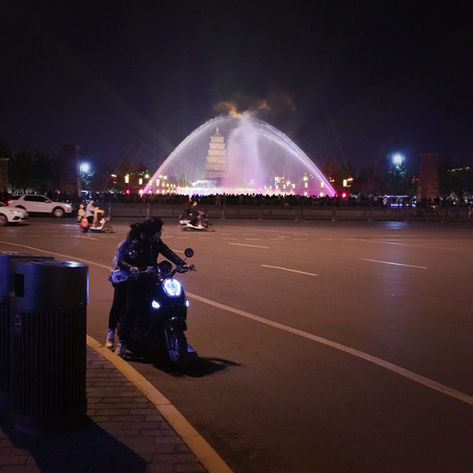
Q & A
Tutu: How are you responding to the pandemic and how dose it affect your art practice?
Yiwen: It all came fast. When the pandemic just got spread I was in Xi’an and shocked heavily. I couldn’t go outdoors or make any artwork for a long time. The one way I stayed in touch with the outside world was through the screen. Information flows were all over the place, and all the opposite and incomprehensible voices online disturbed me. On one night in April, I felt like to take a walk, so I put on my face mask on and headed out. I kept my distance from the people on the roadside. As I approached the Giant Wild Goose Pagoda, I saw a crowd of people in the distance. They were watching the performance of the musical fountain at North Square of the pagoda. At that moment, life seemed to return to a certain kind of normal-a new daily.
Guimi You
received a MA in Painting from Royal College of Art, London, United Kingdom, and a BFA and an MFA in Oriental Painting from Seoul National University, Seoul, Korea. Recent exhibitions include two solo shows in Monya Rowe Gallery, New York; Fourteen 30 Contemporary, Portland, OR; and Drawer, NYC; Kristian Day, London, UK. She has completed residencies at Wassaic Project Winter Residency, Wassaic, NY; Banff Centre Artist in Residency, Banff, Canada; The Studios at MASS MoCA, North Adams, MA; and Vermont Studio Center, Johnson, VT. Guimi lives and works in Berkeley, CA.
Instagram| Facebook
Artist Statement
My paintings describe imaginary scenes based on everyday life, implying the intersection of reality and illusion. The fantastical approach to the painting with ordinary objects such as a living room, brushes, or lights creates ironic and dreamlike spaces within the mundane of everyday. The cloudy and misty manner with pale cream colors suggests the vagueness and mystery of paintings as if they are from a mirage or dream where the description begins to shimmer.

Q & A
Tutu: How are you responding to the pandemic and how dose it affect your art practice?
Guimi: I moved from NY to California just a couple of weeks before the pandemic period began, and I was trying to find a new studio until things got really serious. The pandemic made me end up having a studio in a corner of my apartment. I began to use acrylic paints instead of oil paints that I had used for a while, considering ventilation and brush-wash conditions at home. I somewhat like this home-studio system as I can conveniently start working without any commuting time. However, this home-studio makes me open the fridge frequently.
Tutu: What inspires you the most right now?
Guimi: The pandemic has been allowing me to go out for a walk only near my home. However, thanks to this pandemic, I have had plentiful opportunities to enjoy beautiful street scenery of this town, Berkeley and Albany, in detail that I have never done before. Many blossoms of flowers, trees, and well-maintained gardens inspire me a lot these days.
Diana Zeng
Born in Chengdu, China, Diana Zeng is a visual artist currently based in St. Louis, Missouri. After immigrating to the United States, her family relocated throughout the country on a trek up toward the American Dream. This upbringing made Zeng attuned to expressions of collective kinship and how prejudices come from fear of the unknown. The convergence from her own marriage of families from seemingly foreign worlds ‒ China and America, traditional and queer ‒ is a catalyst for her work. Zeng conceives of possibilities to establish our innate reactions toward the Other, not as stranger, but as kin.
Instagram| Website
Artist Statement
Shelter Me Shelter You is a ritual of daily works. For 72 straight days, I painted scenes and shared stories of people in lockdown during the COVID-19 pandemic. The series spans the time when St. Louis announced its stay-at-home order to the first weekend of the revolutionary Black Lives Matter protests.
The COVID-19 pandemic called on those with the privilege of a safe home to act with consideration for society as a whole. Each space was reimagined in a vibrant color palette that drew refreshed attention to an overly familiar space. The domestic scenes are paired with intimate writings from each resident, and the unfolding of our collective coping reveals a reckoning of emotions - anxiety, boredom, and uneasy gratitude.
This ritual began as a chronicle of stay-at-home scenes fortifying our collective effort to protect society during the COVID-19 global pandemic. But safety and security are not accessible to all. This series ended when the protests for Black lives erupted across the world - protecting society suddenly included going out, not just staying in. Fighting the pandemic that is systemic racism is essential work on the streets and in our homes.











